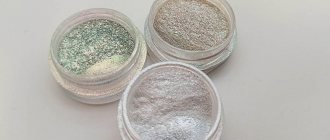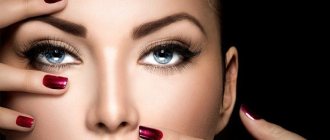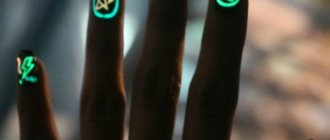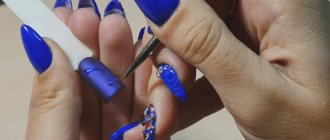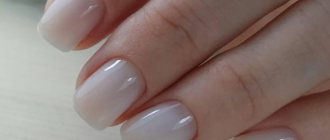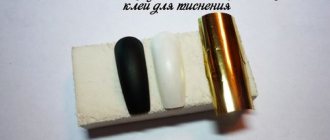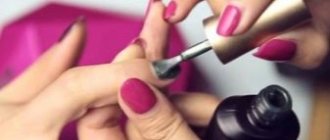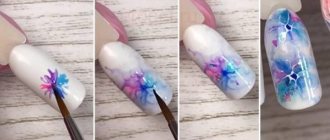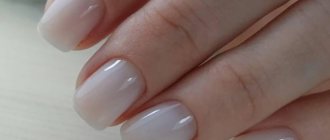Types and characteristics of rubbing
Rubbing is a polyester powder with different degrees of grinding and different effects created.
Usually it is packaged in jars of 1, 2, 3 grams. The powder can be colored, pigmented, or create only the effect of glare and shimmer on the surface of the varnish. It may also contain flakes or small glitter.
For the base-substrate you can use:
- Regular varnish
- Gel polish
- Shellac
- Top coat without color
- Extension gel transparent or camouflage
Camouflage nail gel - let’s figure out what it is and how to use it correctly
There are the following types of nail rubs:
- Chrome or superchrome with metallic effect (gold, silver)
- cat's eye
- Prism (very fine grind)
- Holographic
- Pearl (with or without pigment): mermaid, unicorn, aurora
- Yuki with small flakes
- May bug, combining 2-3 rich colors in a composition
- Chameleon
- Colored, pigmented, covering the shade of the base
- With colored sparkles
- Melange fine
Popular manufacturers of mirror rubbing into gel polish are Irisk, TNL, Bluesky, Fox, Patrisa Nail, Lianail, Nano Professional.
Let's look at the most popular types of nail rubs with illustrative photos:
Mirror rubbing with a metallic effect, also called chrome or superchrome, is the most popular. It doesn't just come in gold or silver. Its peculiarity is an even shiny coating with metallic tints in one color, without transitions. It interrupts the color of the base and can be applied to both dark and light backgrounds.
The chameleon changes color depending on the lighting. The brighter it is, the richer the pigments. You can choose rhinestones to match the color of the rub and create a harmonious nail design. Depending on the color of the base, the chameleon will show a deeper or lighter shade.
Pearl - can be uniform white with a characteristic pearl tint, or contain light pigments of blue, green, pink, creating colored highlights. Pearl pigment with glitter looks good on a light base. The rub can be used for wedding and everyday designs.
Colored mirror rub contains dense pigments that cover the color of the base. They can be applied not to the varnish, but directly to the base, and covered with a top coat. The colored pigments contained in the material create an even color coating.
The Maybug with the “Northern Lights” effect is distinguished by a combination of several dark, rich tones, hence the name of the pigment. Most often it has one distinct color, which is the leading color after application. The combination of blue and green, red and purple, pink and green is suitable for evening looks. The pigments reveal themselves well on long nails, demonstrating all the color transitions. The brighter the lighting and the darker the tone of the base-background, the richer the shine and shades of the “beetle” rub.
Holographic – has a very fine grind and is considered one of the most difficult to apply. It is similar to a prism rub. The main focus of the pigment is on the rainbow circles extending from the central highlight.
Yuki flakes give an effect similar to foil casting. They can be applied in two ways - by patting (foil effect) and rubbing (mirror effect). They can have either a two-color or a transparent base, depending on which they either interrupt or highlight the background varnish.
How to use nail rub
Nail rub is not a fussy material, but it requires some skill and knowledge of certain subtleties. The special composition of the decorative product requires the presence of crumbly glitter, and for their proper application in manicure, there are a number of tools, the purpose of which is highlighted in our table.
| Tool | Purpose |
| File | Abrasiveness from 120 to 180 grit, for correcting the shape and length of natural nails |
| Soft buff | For polishing uneven nail plates |
| Metal pusher | To remove overgrown epidermis and cleanse the nail bed |
| Cuticle scissors or cuticle nippers | To remove skin around the nail. It is recommended to complete this traumatic procedure by applying moisturizing oil |
| Elastic applicator | You can take an eyeshadow brush, whose silicone pad rubs in the glitter well |
| Brushes | Only with densely packed synthetic pile. Option for advanced users |
| Protective liner | To protect your desktop surface from glitter |
Release forms
Rubbing for nail design is available in two formats:
- Crumbly;
- Pressed.
Loose rubbing is a fine powder in a small jar. This is the classic format that is most common.
The second option is pressed or hard rubbing. It is something similar to eye shadow - a small palette with refills - small compartments with pressed rubbing powder, or the same jar, but with solid contents.
There is no fundamental difference between the two formats - the result is the same if you follow the application technology. But masters who have already tried hard rubbing note that it is more practical - nothing crumbles or scatters.
Manicure design with rubbing – fashion trends 2022
A distinctive feature of all fashionable looks in 2022 is femininity and naturalness, so these are the criteria that form the basis of a stylish manicure with rubbing. First of all, this, of course, influenced the choice of the length and shape of the nail plate, and in 2021, according to designers, a smoothly rounded almond or oval shape is the ideal base for a manicure. At the same time, it is important that the length of the free edge is at least 5-7 mm, which once again confirms the gradual return of long nails to fashion.
As for the style direction in manicure, minimalism remains an unchanged trend, as well as the play of textures and accentuation using painting or decorative decorations on a pair of nails.
In addition, any type of rubbing can be used to create a design, which we will discuss in more detail in the next section.
Materials and tools
Mirror pigments can be rubbed in and applied to nails using several different techniques. Next, we will look at the four most popular options, and here we will provide a list of everything that a novice master or amateur needs to master the technology.
- The rubbing itself is the desired color with the desired effect;
- A transparent base, preferably of a liquid consistency, since the design requires a large total number of layers;
- Gel polish, shellac;
- Transparent modeling or camouflage gel (can be used without varnish)
- Top with and without sticky layer. According to the technology, both options can be used; a product with a sticky layer has its own nuances in application;
- Bond or primer, always acid-free, for sealing the ends of the nails;
- Cleaner, degreaser, lint-free wipes;
- Soft brush to remove powder residue;
- Eyeshadow sponge or silicone brush for working with glitter dust.
Why does the nail rub “not rub in”? Possible reasons
In the previous sections, we have already found out what kind of animal this is - the now fashionable metal powder. We figured out how to use a funny powder to create a steel mirage on the nails. And they even began to implement the exciting plan “X”, but something went wrong in the process. The rub came out in flakes, began to flake off, or didn’t “rub in” at all? There is no need to panic; working on mistakes only consolidates your newly acquired knowledge and improves your skills. Find answers to all your questions in the video:
Mirror, chrome, holographic rainbow and even unicorn rub. So many ways to brighten up your everyday life. Which one is closest to you?
Applying a rub on gel polish, shellac with top coat without a sticky layer
This is the most common, classic method of applying mirror pigment. Before performing the design, it is recommended to have a trimmed or hardware manicure. This is the first preparatory stage for all of the following methods of applying the rub.
Nails are degreased and covered with a thin layer of base. After drying the base, apply two more layers of gel polish or shellac, allowing each to dry.
- We apply the top without a sticky layer, level the surface of the coating, and send it to dry for half the time recommended for complete drying. For example, 60 seconds in a 38W UV lamp and 30-40 seconds in a 36-48W LED lamp.
- It is recommended to apply the top one finger at a time before rubbing, so that it does not have time to cool, and it is well distributed, without bald spots.
- Apply mirror powder to your nails with your finger, sponge or brush and rub in well, spreading from the center to the edges. Don't skimp on rubbing; it's better to brush off the residue with a brush. If you apply the powder with your finger, it is recommended to work hard-to-reach corners with a thin brush. This is true when applying background gel polish under the cuticle. Afterwards, brush off the remaining rubbing compound with a soft brush. Do not use brushes to avoid scratching the mirror texture.
- The pigment is covered with a top or finish in two layers to ensure the result is well secured. The first layer should be distributed very carefully, without pulling.
- After drying the first layer in a lamp, it is important to treat the ends of the nails well, otherwise the powder may chip off, because it does not have a strong adhesion to the material.
- Using a file, the edge of the nails is completely removed from the bottom and sides, up to the growth zone. The filing areas are treated with an acid-free bond so that the primer does not get on the surface of the nail. Usually the bond dries in the open air for 2 minutes. Some brands – from 30 to 60 seconds, you need to look at the recommendations on the packaging.
- After the bond has dried, a second layer of topcoat is applied, the ends are sealed and everything is dried in a lamp. Mirror manicure is ready!
What is a nail rub?
Nail rub is a special finely ground acrylic powder. Its particles are so miniature and weightless that when applied they fit tightly to each other, creating the illusion of an absolutely smooth metallized surface. Usually this pigment for design is sold in a jar and its price is very symbolic, but consumption, on the contrary, is very economical.
Chrome rubbing is similar in properties to foil, but significantly exceeds it in terms of durability and reflective capabilities. It has a number of advantages that not only professional nail technicians, but also beginners should know about:
- unlike varnish containing glitter, the coating with grout is easily removed from the nails without unnecessary friction;
- wide price range and the widest choice of palettes. There are even brands that make a vegan rub that is not tested on animals. A striking example of this is the company Severin or Melange;
- It’s easy to create shiny nails at home, because it doesn’t require any special skills or additional tools;
- volumetric design on nails? It’s elementary, just sprinkle a drop of glitter on the sticky layer of the design. The powder will evenly cover the decor and fix itself on it;
- regular shellac extends its original durability when grout is applied to it.
Applying rub on top with dispersion
A professional nail artist always has several options for tops in his arsenal, but what should an amateur beginner who only has a top with a sticky layer in his cosmetic bag do? You can come out of this situation with a good result.
- The procedure for preparing nails for applying the rub is the same as in the first method.
- After drying two layers of gel polish, apply a top coat with a dispersion layer to the nails and cure in a lamp for half the standard time.
- From the still warm top, remove the sticky layer with a napkin, and while the clinser on the surface is not completely dry and the top is warm, distribute the powder until the desired uniform shine is obtained.
In this option, it is very important to treat the nails one at a time so that they do not have time to dry out after removing the dispersion and cool down after the lamp. After rubbing in the powder, cover the nails with one layer of top coat, treat the ends as in the first method, and seal them together with the second coat of top coat.
Pearl rub step by step
A special feature of pearl rubbing is a more natural appearance of nails than when using mirror pigment. This technique is used to create a classic look (it is especially popular among brides). Finely ground polyester dust produces a uniform glow under different light sources.
Mother-of-pearl rub creates a pearl effect
The powder is easy to use. To apply pearl rub on gel polish, no additional skills are required.
The technique is as follows:
- perform a trim manicure and treat your nails with a degreaser;
- Apply the base, remembering to seal the end of each nail. Dry in a lamp;
- Cover your nails with colored gel polish (2 – 3 layers). Dry each layer;
- remove the sticky layer using a degreaser;
- Apply pearl rub using the applicator and spread it over the surface;
- put your nails in the lamp, then apply the finish and dry again.
The nail is given a beautiful mirror shine
To apply the pigment, you can use not only a special applicator, but also a brush or sponge. Pearl powder is absolutely difficult to use.
Applying a mirror or colored rub directly onto gel polish, without topcoat
This method differs in that we get fewer layers of topcoat as a result, and the manicure does not look as dense. This will save time for professional professionals when there is a heavy flow of clients.
- Pink rub is applied to black gel polish. After drying the second layer of gel polish, remove the dispersion from it and get a matte background.
- Wet the tip of your finger in alcohol or cleanser, dip it in mirror powder, and rub it into the gel polish or shellac. The finger should always be wet when working with the rub. The secret of this method is that the alcohol or clinser quickly dries, evaporates, and a beautiful mirror finish is obtained. The rubbing time may be seconds longer than usual, but the mirror effect is the same.
- We seal the mirror layer with two layers of topcoat, filing the tips and ends of the nails after the first, and sealing them with the finish when applying the second.
"Broken glass"
A creative design in a snow-white interpretation looks like a cracked eggshell on the nail plates. Extraordinary nail art can be successfully combined with various decorative options. They use a special manicure foil, which generates spectacular silver, gold or bronze tints under a colorless topcoat. This design is distinguished by visual lightness and tenderness.
It attracts the eye with its unique creative twist, simulating the cracked surface of the nail plates. Shards of broken glass on a white background can be recreated using colored foil or fragments of polymer film of unequal sizes.

